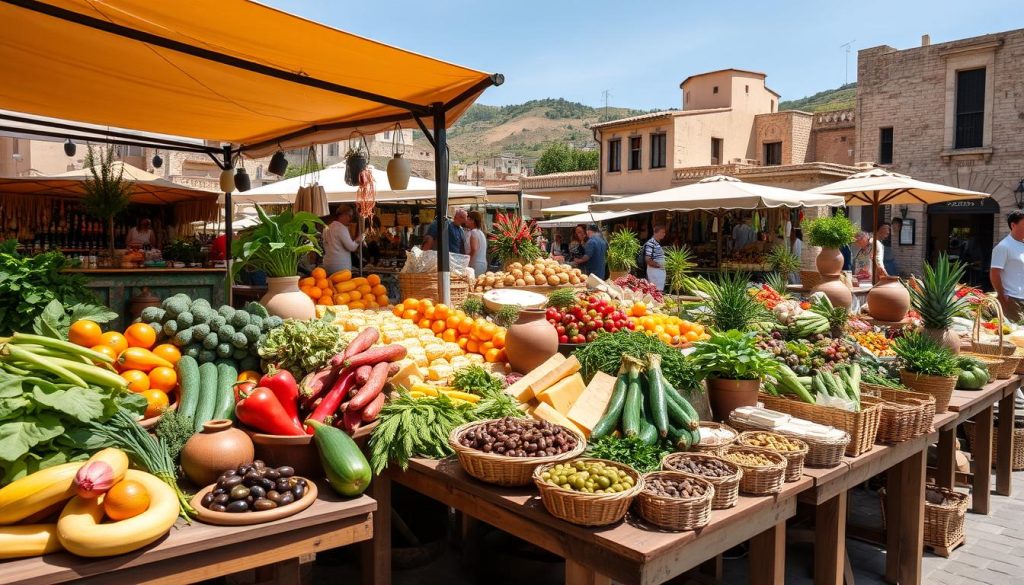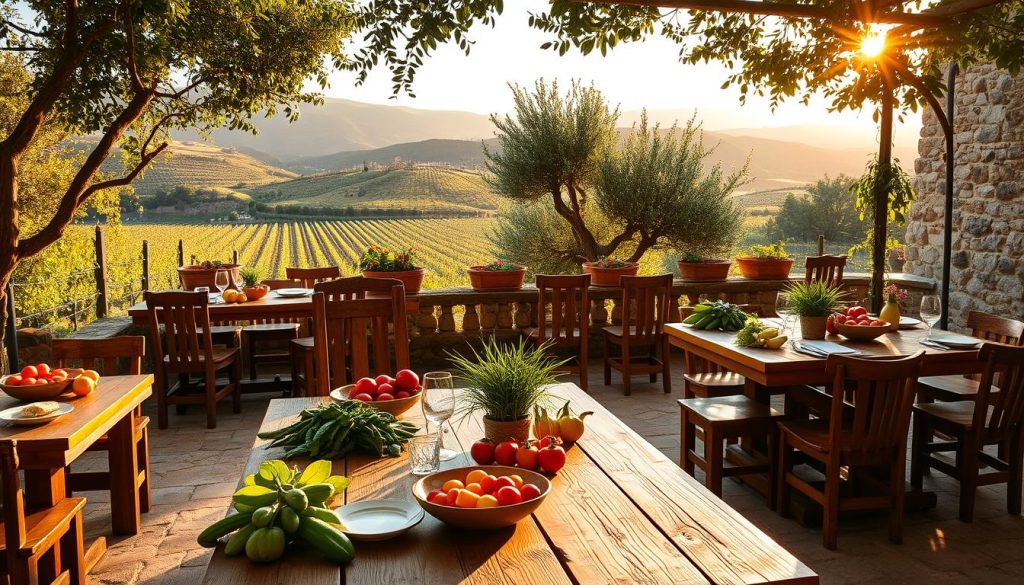The farm-to-table movement is growing fast, especially in beautiful places like Sicily. This restaurant opening guide will show you how to start a farm-to-table place in this island paradise. Sicily is perfect for this because of its rich farming history and varied food traditions.
By focusing on Sicily dining and sustainable restaurant practices, you can make a unique and successful restaurant. This guide will highlight the benefits of this approach in Sicily.
Key Takeaways
- The farm-to-table concept emphasises local sourcing of ingredients.
- Sicily’s agricultural diversity enriches restaurant menus.
- Sustainable practices enhance the dining experience.
- A strong community connection is essential for success.
- The restaurant environment plays a crucial role in attracting customers.
Understanding the Farm-to-Table Concept

The farm-to-table idea means getting food straight from local farmers. This makes meals fresh and full of flavour. It also helps the local economy and brings people together.
Using seasonal ingredients is key to farm-to-table. These ingredients taste better and are better for the planet. They reduce the need for long-distance food transport.
Restaurants must be flexible with their menus. They change often to reflect what’s in season. This creativity shows off the variety of local produce.
The Appeal of Sicilian Culinary Traditions

Sicilian cuisine is a mix of flavours and cultures. It has been shaped by Arab, Spanish, and Greek invasions. These events left their mark on its cooking traditions.
Each culture brought new ingredients and ways of cooking. This has created a wide range of flavours that excite the taste buds.
Local dishes like arancini, caponata, and pasta alla norma show off the island’s fresh ingredients. These dishes use vegetables, seafood, and herbs from the area. They fit perfectly with the idea of eating food that’s grown locally.
Sicily’s food traditions celebrate its rich land and focus on sustainability and community. The lively markets and family farms show the region’s dedication to its food heritage. Restaurants that use these local flavours offer a true taste of Sicily. They attract both locals and visitors, making Sicilian food a key part of the farm-to-table movement.
Locally-Sourced Ingredients: The Heart of Your Menu

Starting a farm-to-table restaurant in Sicily means using local ingredients is key. These ingredients bring the true taste of Sicily to your guests. It’s a way to share the region’s flavours.
Sicily’s climate is perfect for growing fresh fruits and veggies. You’ll find tomatoes, citrus fruits, and artichokes here. The island also offers top-notch meats and dairy, like cheeses and free-range poultry. Working with local farmers keeps your menu fresh and exciting.
Seasonal menus are essential. They change with the seasons, offering the best of what’s available. This makes dining out a special experience. Customers love trying new dishes that reflect the local harvest.
Building strong ties with local farmers is also important. It helps restaurants know what’s coming in. This partnership supports sustainable farming and benefits everyone involved.
Choosing the Right Location for Your Restaurant

Finding the perfect spot for your farm-to-table restaurant in Sicily is key to success. You need to think about a few important things. Visibility is crucial for attracting customers. A spot that’s easy to see from busy streets or tourist hotspots is ideal.
Accessibility is also a big deal. People like places that are easy to get to and have good parking. Doing a market analysis helps find the right spot. It should have both locals and tourists, perfect for your farm-to-table concept.
When looking at places for your restaurant, keep these points in mind:
- Foot Traffic: Check how many people walk by in different areas, especially when tourists are around.
- Visibility: Find spots that are visible from main streets or landmarks.
- Competitive Landscape: Look at other restaurants nearby to see if there’s enough demand.
- Local Amenities: Being close to other businesses can bring in more customers.
By carefully looking at these factors, you can pick a location that meets your needs. It should also help your farm-to-table restaurant stand out in a competitive area. A good market analysis will give you the insights you need to succeed in Sicily’s lively food scene.
Opening a Farm-to-Table Restaurant in Sicily

Starting a farm-to-table restaurant in Sicily needs careful thought about who you’re serving. Knowing your customers well helps shape your menu and atmosphere. This way, you attract both locals and tourists looking for real food experiences.
Identifying Your Target Market
To find your target market, do a deep dive into the local scene. Look at what locals want in fresh, local food. Also, think about tourists who love trying new, farm-to-table places. Important things to note include:
- Age groups that visit your place.
- What they like to eat and what they can’t.
- How much they’re willing to spend on food out.
Knowing who you’re serving helps you create a menu and vibe that they’ll love. Asking for feedback online or through surveys can help you get even better at meeting their needs.
Assessing Local Competition
Doing a good competitive analysis means looking at other farm-to-table spots in the area. See what they do well and what they don’t. Here’s how to do it right:
- Check out the ingredients they use and where they get them.
- Go to their places to see how customers feel.
- Look at what people say online about their food.
This helps you spot what’s missing in the market. You can then offer something special and stand out from the crowd. Focus on quality, being real, and working with local suppliers to make your place unique.
Sustainable Practices in the Restaurant Industry

Embracing sustainable practices is key in the restaurant world. Places that focus on eco-friendly dining can greatly cut their environmental footprint. This not only boosts their reputation but also draws in more eco-aware customers.
One important step is to reduce waste. Restaurants can do this by planning their menus well. This means:
- Creating dishes with seasonal produce
- Encouraging customers to order smaller portions
- Starting composting for organic waste
Adding recycling efforts shows a restaurant’s dedication to being green. Properly sorting recyclables from trash can significantly reduce landfill waste. Also, using eco-friendly materials in design and operation strengthens the sustainable vibe. This includes:
- Choosing biodegradable packaging for takeout
- Buying sustainable furniture and decor
- Installing energy-saving appliances to cut down on energy use
By focusing on sustainability, restaurants help the environment and win customer loyalty. More and more people want to eat at places that share their values. So, eco-friendly dining is a smart move in today’s market.
Building Relationships with Local Farmers

Creating strong bonds with local farmers is key for a farm-to-table restaurant in Sicily. These connections help restaurants offer fresh, local ingredients. Knowing what’s in season lets them create new dishes that customers love.
It’s important to engage with the community through farm collaborations. This helps both farmers and restaurant owners:
- Organise farm tours and tasting events that showcase local produce.
- Participate in farmers’ markets to create visibility and build rapport.
- Offer seasonal specials that highlight the breadth of local sourcing.
- Involve farmers in menu design to provide authenticity and diversify offerings.
Case studies show the good results of these partnerships. Restaurants see more interest in local food, thanks to the stories of their farmer friends. This growth benefits both the restaurant and the local farmers, making dining more sustainable.
Creating a Unique Dining Experience in Sicily

To make a dining experience in Sicily stand out, mix thematic dining with local traditions. It’s key to embrace Sicilian culture to create unforgettable moments. Adding local art and music to the restaurant’s vibe shows off the island’s lively heritage.
When planning the dining experience, think about these points:
- Ambience: Opt for warm lighting and rustic decor that captures Sicily’s charm. Use natural materials to highlight the region’s farming heritage, making the dining space more inviting.
- Thematic Dining: Design a menu that tells a story, featuring dishes inspired by Sicilian recipes. Each meal can celebrate local produce, sticking to the farm-to-table philosophy.
- Service Style: Train staff to show true Sicilian hospitality, offering genuine warmth and care. A friendly service makes guests feel special and valued.
An immersive setting not only satisfies but also deepens the connection to Sicily’s flavours and traditions. With careful thought and creativity in every detail, your restaurant will be a top spot for celebrating Sicily’s unique culinary spirit.
Understanding Regulatory Requirements

Starting a farm-to-table restaurant in Sicily means knowing the rules well. It’s key to follow restaurant regulations to succeed. You need to understand health codes for food safety and environmental rules.
Before opening, you must get all the necessary permits. This involves a lot of paperwork and inspections.
Important areas to focus on include:
- Food safety standards mandated by health codes.
- Environmental regulations related to waste management and sustainability.
- Building codes that affect the physical structure of the restaurant.
- Permits required for serving alcohol, if applicable.
Knowing these rules helps you follow industry standards. It’s crucial for building a good reputation. You can find help to deal with the paperwork and inspections.
Developing a Winning Business Plan

A strong business plan is key for any restaurant’s success, especially in the farm-to-table market. It’s important to include all the necessary parts for a solid strategy.
Begin with a detailed market analysis. Knowing your target audience and their likes is vital. Look at your competitors to see how you can be different.
Financial forecasting is also crucial. You need to estimate costs, revenues, and ongoing expenses. Your projections should be realistic and based on a deep understanding of the market and your plans.
Then, outline your operational plans. This includes staff needs, supplier relationships, and menu development. Show how you’ll manage resources well to make profits.
When you present your plan, be clear and professional. Use charts and graphs to show financial data. Practice your pitch to show you’re confident in your restaurant’s success.
By combining these steps, you’ll increase your chances of getting funding. A well-made plan will guide you to achieving your goals.
The Role of Marketing in Your Farm-to-Table Restaurant

Marketing is key to a farm-to-table restaurant’s success. It boosts visibility and connects with the community. Using smart marketing, you can grow your brand and reach out more effectively.
Utilising Social Media for Outreach
Social media is a powerful tool for marketing. It lets you share your menu, behind-the-scenes moments, and special dining experiences. Eye-catching images and stories build a strong bond with your followers.
Keeping your social media active keeps people interested in what you offer. It’s a great way to stay in touch with potential customers.
Engaging with the Local Community
Connecting with the local community is vital. Working with local farms and events can raise your restaurant’s profile. Being part of community activities shows your dedication to the area.
Hosting events for locals can create a loyal customer base. It’s a great way to build lasting relationships.
Designing an Inviting Restaurant Atmosphere

Creating a welcoming atmosphere in a restaurant is key to making customers feel at home. Good restaurant design greatly improves the dining experience. It’s all about finding the right mix of function and beauty.
Interior decor sets the mood. Think about the colours, furniture, and art that match your restaurant’s theme. A great atmosphere is more than just looks; it’s the feeling guests get when they walk in.
- Seating should be cozy but also allow for easy movement. Group seating encourages people to chat.
- Soft, adjustable lighting makes the place feel welcoming. It suits any meal, from a quick lunch to a fancy dinner.
- Adding plants brings a calming touch and adds to the beauty of the space.
By focusing on these design elements, restaurants can make every guest feel special. This leads to memorable meals that focus on both comfort and style.
Hiring and Training Staff for Quality Service

In the competitive world of the restaurant industry, the quality of service is key. Finding the right staff is crucial. They need the right skills and a passion for great service. This ensures a top-notch customer experience.
After hiring the right people, it’s time for training. These programs should focus on customer service. They should teach staff how to communicate well, know the menu, and handle different customer needs.
Team building is important for a good team spirit. Regular team activities can make staff work better together. This improves service and makes everyone happier and more focused on customers.
Investing in staff through training helps keep them. A well-trained team is more confident and committed to excellent service. This leads to happy customers and a successful restaurant.
Measuring Success and Adapting Your Business Model
Setting up good performance metrics is key for your farm-to-table restaurant in Sicily to succeed. You should regularly check your financial health. Look at things like how much money you make, how much it costs to get new customers, and your profit margins.
Knowing these numbers helps you see how well you’re doing. It also helps you make smart changes to how you run your business.
It’s also important to listen to what your customers say. Ask for their feedback through surveys or just by talking to them. This helps you know what you’re doing right and what you can improve.
Feedback is crucial for making your menu and dining experience better. It helps you stay in tune with what your customers want.
In a competitive market, being able to change quickly is essential. Keep checking how your changes are working. This lets you make quick adjustments to your business model.
Be open to new ideas and trends, but always stay true to Sicilian cooking. This way, you can grow and become a beloved place to eat in Sicily.









